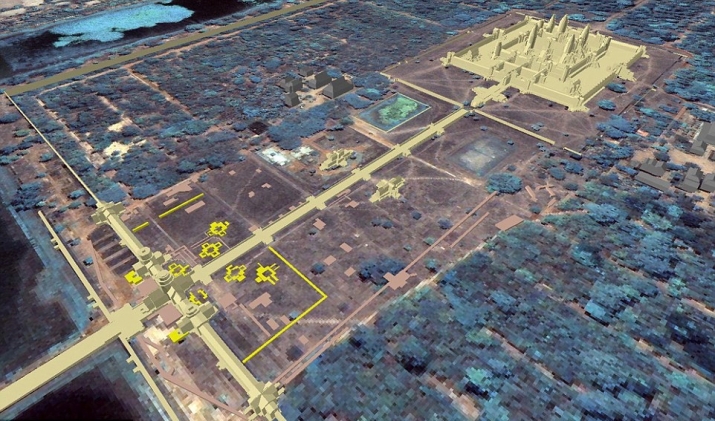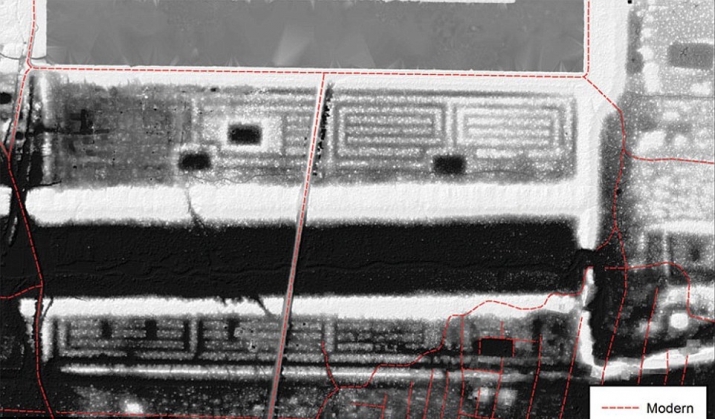NEWS
Newly Discovered Structures Suggest Angkor Wat is Larger than Previously Thought
 New discoveries made with advanced imaging technology indicate the Angkor Wat complex may be far larger than previously believed. From wikipedia.org
New discoveries made with advanced imaging technology indicate the Angkor Wat complex may be far larger than previously believed. From wikipedia.orgA team of archaeologists has discovered a number of buried towers and the remains of a huge structure of unknown function near Cambodia’s Angkor Wat, the world’s largest religious monument. The discoveries, which also include what appear to be residential structures and wooden fortifications, suggest that the ancient Buddhist complex is far larger than previously thought.
Covering an area of more than 400 acres, the Angkor Wat complex is one of the most important archaeological sites in Southeast Asia. It is the best-known site in the forested Angkor Archaeological Park, a protected UNESCO World Heritage Site spread over 154 square miles in Cambodia’s northern province of Siem Reap. The area also contains the remains of various capitals of the Khmer Empire dating from the 9th–15th centuries, including the Bayon Temple at Angkor Thom.
A team of researchers led by Prof. Roland Fletcher and Dr. Damian Evans from Australia’s University of Sydney surveyed the area using ground-penetrating radar, airborne laser scanning (LiDAR) technology, and targeted excavation, as part of the Angkor Research Program. The team’s discoveries include an ensemble of eight buried towers built and later demolished during the construction of the main temple, part of the remains of what is thought to have been a shrine used during the construction.
 Using LiDAR technology and ground-penetrating radar, researchers mapped eight buried towers on the grounds of Angkor Wat, indicated in bright yellow. From dailymail.co.uk
Using LiDAR technology and ground-penetrating radar, researchers mapped eight buried towers on the grounds of Angkor Wat, indicated in bright yellow. From dailymail.co.ukSpeaking of the largest discovery, notable not only for its size, but also for featuring large rectangular spiral structures built out of sandstone and laterite, Fletcher said, “This structure, which has dimensions of more than 1500m by 600m [1,640 by 656 yards], is the most striking discovery associated with Angkor Wat to date. Its function remains unknown and, as yet, it has no known equivalent in the Angkorian world.” (The University of Sydney)
The team also found wooden fortifications built late in Angkor Wat’s history, offering insights into how the temple may have been converted into a defensive stronghold against incursions by the powerful kingdom of Ayutthaya in present-day Thailand.
“Angkor Wat is the first and only known example of an Angkorian temple being systematically modified for use in a defensive capacity,” said Fletcher. “The available evidence suggests it was a late event in the history of Angkor, either between AD 1297 and 1585, or perhaps sometime between AD 1585 and the 1630s. Either date makes the defenses of Angkor Wat one of the last major constructions at Angkor and is perhaps indicative of its end.” (The University of Sydney)
The LiDAR survey revelations also challenge previous theories about the area surrounding the main temple of Angkor Wat, which was generally assumed to have been used as sacred “temple-cities” for monastic communities. There is now evidence of low-density residential structures, including a network of roads, ponds, and mounds that may have been used by people tasked with servicing the temple.
 The archaeologists have uncovered a huge sandstone structure, which they describe as "the most striking discovery associated with Angkor Wat to date.” From dailymail.co.uk
The archaeologists have uncovered a huge sandstone structure, which they describe as "the most striking discovery associated with Angkor Wat to date.” From dailymail.co.uk“This challenges our traditional understanding of the social hierarchy of the Angkor Wat community and shows that the temple precinct, bounded by moat and wall, may not have been exclusively the preserve of the wealthy or the priestly elite,” said Fletcher. (The University of Sydney)
Angkor Wat was initially designed and constructed as a Hindu temple in the first half of the 12th century, during the reign of Suryavarman II (r. c. 1113–50), before becoming a Buddhist temple toward the end of the century. Before the end of the 15th century, the expanding kingdom of Ayutthaya launched several attacks on Angkor, then one of the great powers in the region, leading to a gradual diminishment of Angkor's influence on the Chao Phraya River Plain.
See more
New discoveries redefine Angkor Wat's history (The University of Sydney)
ANGKOR RESEARCH PROGRAM (The University of Sydney)
Archaeology: Angkor Wat in Cambodia Was Larger and Different Than Thought (Nature World News)
Angkor Wat Larger, More Complex than Previously Thought (New Historian)
Angkor Wat Yields Astounding Buried Towers & Spiral Structure (Live Science)
Cambodia: Huge structure discovered at Angkor Wat shows religious monument is more complex than thought (International Business Times)
Angkor (UNESCO)














